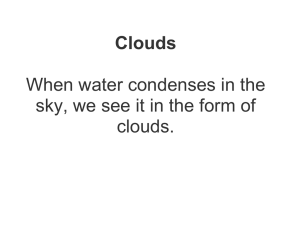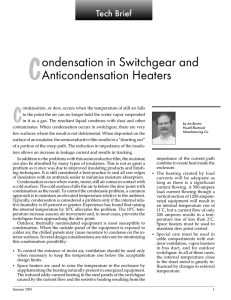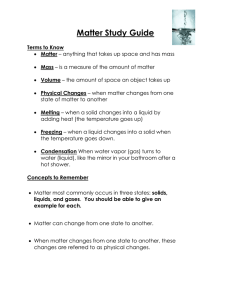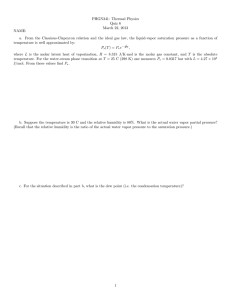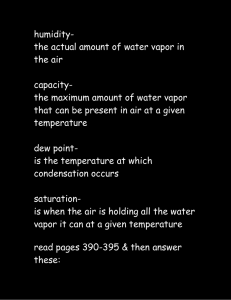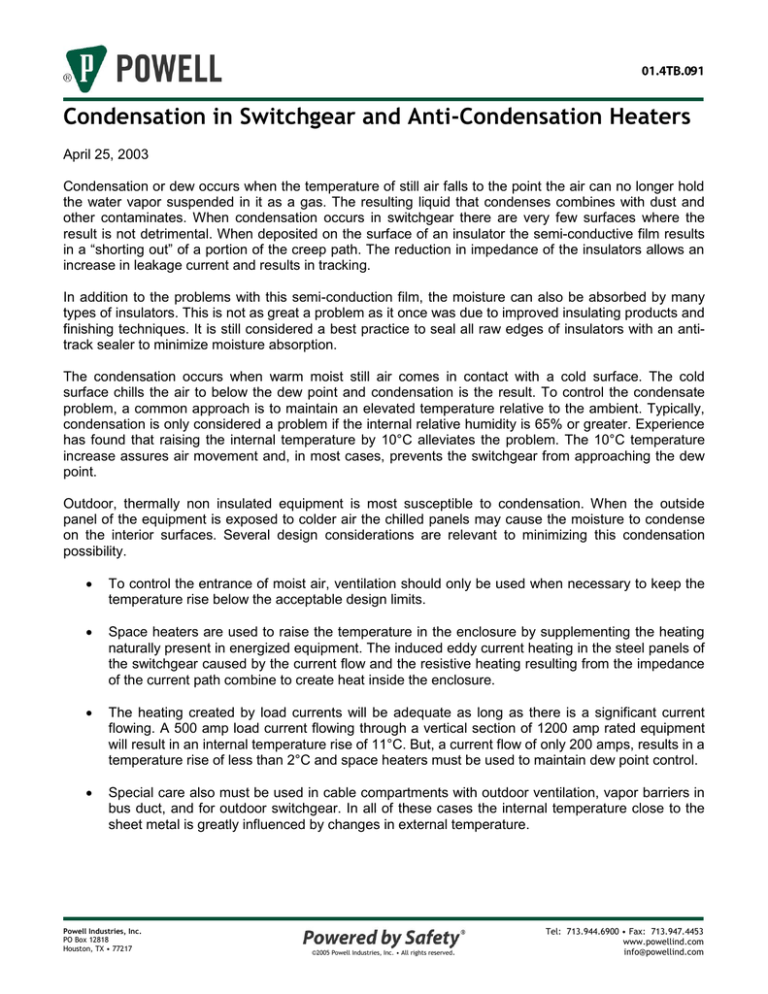
Condensation in Switchgear and Anti-Condensation Heaters
April 25, 2003
Condensation or dew occurs when the temperature of still air falls to the point the air can no longer hold
the water vapor suspended in it as a gas. The resulting liquid that condenses combines with dust and
other contaminates. When condensation occurs in switchgear there are very few surfaces where the
result is not detrimental. When deposited on the surface of an insulator the semi-conductive film results
in a “shorting out” of a portion of the creep path. The reduction in impedance of the insulators allows an
increase in leakage current and results in tracking.
In addition to the problems with this semi-conduction film, the moisture can also be absorbed by many
types of insulators. This is not as great a problem as it once was due to improved insulating products and
finishing techniques. It is still considered a best practice to seal all raw edges of insulators with an antitrack sealer to minimize moisture absorption.
The condensation occurs when warm moist still air comes in contact with a cold surface. The cold
surface chills the air to below the dew point and condensation is the result. To control the condensate
problem, a common approach is to maintain an elevated temperature relative to the ambient. Typically,
condensation is only considered a problem if the internal relative humidity is 65% or greater. Experience
has found that raising the internal temperature by 10°C alleviates the problem. The 10°C temperature
increase assures air movement and, in most cases, prevents the switchgear from approaching the dew
point.
Outdoor, thermally non insulated equipment is most susceptible to condensation. When the outside
panel of the equipment is exposed to colder air the chilled panels may cause the moisture to condense
on the interior surfaces. Several design considerations are relevant to minimizing this condensation
possibility.
To control the entrance of moist air, ventilation should only be used when necessary to keep the
temperature rise below the acceptable design limits.
Space heaters are used to raise the temperature in the enclosure by supplementing the heating
naturally present in energized equipment. The induced eddy current heating in the steel panels of
the switchgear caused by the current flow and the resistive heating resulting from the impedance
of the current path combine to create heat inside the enclosure.
The heating created by load currents will be adequate as long as there is a significant current
flowing. A 500 amp load current flowing through a vertical section of 1200 amp rated equipment
will result in an internal temperature rise of 11°C. But, a current flow of only 200 amps, results in a
temperature rise of less than 2°C and space heaters must be used to maintain dew point control.
Special care also must be used in cable compartments with outdoor ventilation, vapor barriers in
bus duct, and for outdoor switchgear. In all of these cases the internal temperature close to the
sheet metal is greatly influenced by changes in external temperature.
Powell Industries, Inc.
PO Box 12818
Houston, TX • 77217
©2005 Powell Industries, Inc. • All rights reserved.
Tel: 713.944.6900 • Fax: 713.947.4453
www.powellind.com
info@powellind.com
Condensation in Switchgear and Anti-Condensation Heaters
page 2
For further reading I extracted the following information from the web to provide a better understanding of
the definition of dew point and relative humidity.
What is “Dew Point and Relative Humidity?”
“The warmer the air, the more water vapor it can hold”. Dew point is a measure of how much water vapor
is actually in the air. Relative humidity is a measure of the amount of water in the air compared with the
amount of water the air could hold at the measurement temperature. To see how this works, let’s use the
chart below which is adapted from Meteorology Today by C. Donald Ahrens, published by West
Publishing.
Air Temperature in ºC
30 degrees
20 degrees
10 degrees
Water Vapor Air Can Hold at This Temperature
30 grams per cubic meter of air
17 grams per cubic meter of air
9 grams per cubic meter of air
These numbers, which apply to air at sea level pressure, are based on measurements over the years.
They are basic physical facts.
Now, let’s see how dew point and relative humidity work. Imagine that at 3:00 pm you measure the air
temperature at 30°C and you measure its humidity at 9 grams per cubic meter of air. What would happen
if this air cooled to 10°C with no water vapor being added or taken away? As is cools to 10°C, the air
becomes saturated; that is, it cannot hold any more water vapor than 9 grams per cubic meter. Cool the
air even a tiny bit more and its water vapor will begin condensing to form dew. Back at 3:00 pm, when
the measurements were taken, we could say that the air’s dew point was 10°C. That is, if this particular
air were cooled to 10°C at ground level, its humidity would begin condensing to form dew.
How about relative humidity? At 3:00 pm the air has 9 grams of water vapor per cubic meter of air. We
divide 9 by 30 and multiply by 100 to get a relative humidity of 30%. The air actually has 30% of the
water vapor it could hold at its current temperature. Cool the air to 20°C. Now we divide 9 grams of water
vapor, the vapor actually in the air, by 17, the amount of vapor it could hold at its new temperature, and
multiply by 100 to get a relative humidity of approximately 53%. Finally, when the air cools to 10°C, we
divide 9 by 9 and multiply by 100 to get a relative humidity of 100%. The air now has as much vapor as it
can hold at its new temperature.
Powell Industries, Inc.
PO Box 12818
Houston, TX • 77217
©2005 Powell Industries, Inc. • All rights reserved.
Tel: 713.944.6900 • Fax: 713.947.4453
www.powellind.com
info@powellind.com
Condensation in Switchgear and Anti-Condensation Heaters
page 3
What does all this mean to Powell switchgear designs?
At Powell we recommend these guidelines for minimizing the possibility of condensation:
We recommend installation of two 125 watt space heaters in each of the cable and the circuit
breaker compartments for:
o 27kV and 38kV indoor switchgear
o 5kV and 15kV outdoor switchgear
o 15kV indoor switchgear with current transformer ratios of 200:5 and smaller mounted on
the insulation spouts. This is to compensate for lack of heat and air flow due to low
operating current and the lower associated eddy current and conductor resistance
heating effects.
We recommend installation of one 125 watt space heater in each of the cable and circuit breaker
compartments for indoor 5kV and 15kV switchgear.
We recommend thermostatic control to be included on all space heater circuits with the heaters
set to turn off at 60°C +/- 5°C.
We recommend a second set of space heaters be added to that already recommended and set
for operation at 10°C +/- 5°C for applications operating for extended periods in climates below
0°C.
We recommend installation of space heaters within 2 feet of the outdoor side of any bus duct
vapor barrier to prevent condensation when the bus duct is not energized.
We recommend epoxy or porcelain standoff insulators for outdoor equipment due to the low
water absorption nature of the material.
We recommend that clients specify an ammeter in each space heater circuit to monitor circuit
health and, if a smart substation is purchased, include transducers to monitor each space heater
circuit.
We recommend the use of enclosures designed to minimize the chance of condensation falling
or dripping onto current carrying parts.
Jim Bowen
Technical Director
Powell Industries, Inc.
PO Box 12818
Houston, TX • 77217
©2005 Powell Industries, Inc. • All rights reserved.
Tel: 713.944.6900 • Fax: 713.947.4453
www.powellind.com
info@powellind.com

